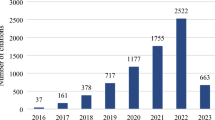Abstract
We investigate the use of higher order inclusion functions in the Moore–Skelboe (MS) algorithm of interval analysis (IA) for unconstrained global optimization. We first propose an improvement of the Taylor–Bernstein (TB) form given in (Lin and Rokne (1996) 101) which has the property of higher order convergence. We make the improvement so that the TB form is more effective in practice. We then use the improved TB form as an inclusion function in a prototype MS algorithm and also modify the cut-off test and termination condition in the algorithm. We test and compare on several examples the performances of the proposed algorithm, the MS algorithm, and the MS algorithm with the Taylor model of Berz and Hoffstatter (1998; 97) as inclusion function. The results of these (preliminary) tests indicate that the proposed algorithm with the improved TB form as inclusion function is quite effective for low to medium dimension problems studied.
Similar content being viewed by others
References
Berz, M. and Hoefkens, J. (2001), COSY INFINITY Version 8.1 Programming Manual, Technical Report MSUCL-1196, National Superconducting Cyclotron Laboratory, Michigan State University, East Lansing, MI 48824.
Berz, M. and Hoffstatter, G. (1998), Computation and Application of Taylor Polynomials with Interval Remainder Bounds, Reliable Computing, 4: 83–97.
Cargo, G.T. and Shisha, O. (1966), The Bernstein Form of a Polynomial, J. Research of NBS, 70B, 79–81.
Csendes, T. and Ratz, D. (1997), Subdivision Direction Selection in Interval Methods for Global Optimization, SIAM J. Numerical Analysis, 34: 922–938.
Garloff, J. (1993), The Bernstein Algorithm, Interval Computations, (2), 155–168.
Garloff, J. and Smith, A.P. (2000), Investigation of a Subdivision Based Algorithm for Solving Systems of Polynomial Equations, in Proc. of the 3rd World Congress of Nonlinear Analysts (WCNA 2000), Catania, Sicily, Italy.
Garloff, J. and Smith, A.P. (2001), Solution of Systems of Polynomial Equations by Using Bernstein Expansion, in Alefeld, G., Rump, S., Rohn, J. and Yamamoto, T. (eds.), Symbolic Algebraic Methods and Verification Methods, Springer, Germany.
Gay, D.M. (1984), A trust region approach to linearly constrained optimization, in Griffiths, D.F. (ed.), Numerical Analysis, Lecture Notes in Mathematics 1066, Springer, Berlin.
Hansen, E. (1992), Global Optimization Using Interval Analysis. Marcel Dekker, New York.
Hoefkens, J. (2001), Rigorous Numerical Analysis with High-Order TaylorModels. PhD thesis, Michigan State University, East Lansing, Michigan, USA, also MSUCL-1217.
Ichida, K. and Fujii, Y. (1979), An Interval Arithmetic Method for Global Optimization, Computing, 23, 85–97.
Kearfott, R.B. (1996), Rigorous Global Search: Continuous Problems. Kluwer Academic Publishers, Dordrecht.
Kearfott, R.B. and Arazyan, A. (2000), Taylor Series Models in Deterministic Global Optimization, in Proc. 3rd Int. Conf. and Workshop on Automatic Differentiation, June 2000.
Lin, Q. and Rokne, J.G. (1996), Interval Approximation of Higher Order to the Ranges of Functions. Computers Math. Appl. 31(7), 101–109.
Makino, K. and Berz, M. (1996), Remainder Differential Algebras and their Applications, in Berz, M., Bischof, C., Corliss, G. and Griewank, A. (eds.), Computational Differentiation: Techniques, Applications and Tools, pp. 63–75. SIAM.
Malan, S., Milanese, M., Taragna, M. and Garloff, J. (1992), B3 Algorithm for Robust Performance Analysis in Presence of Mixed Parametric and Dynamic Perturbations, in Proc. of the 31st IEEE CDC, pp. 128–133.
Moore, R.E. (1966), Interval Analysis, Prentice-Hall, Englewood Cliffs, N.J.
Moore, R.E. (1979), Methods and Applications of Interval Analysis, SIAM, Philadelphia.
Moore, R.E. and Ratschek, H. (1988), Inclusion Functions and Global Optimization II, Mathematical Programming, 41, 341–356.
More, J.J., Garbow, B.S. and Hillstrom, K.E. (1981), Testing Unconstrained Optimization Software, ACM Trans. Mathematical Software, 7(1), 17–41.
Ratschek, H. Inclusion Functions and Global Optimization, Mathematical Programming, 33: 300–317.
Ratschek, H. and Rokne, J. (1984), Computer Methods for the Range of Functions, Ellis Horwood Limited, Chichester.
Ratschek, H. and Rokne, J. (1988), New Computer Methods for Global Optimization, Wiley, New York.
Zettler, M. and Garloff, J. (1998), Robustness Analysis of Polynomials with Polynomial Parameter Dependency using Bernstein Expansion, IEEE Trans. on Automat. Control, 43(3), 425–431.
Author information
Authors and Affiliations
Rights and permissions
About this article
Cite this article
Nataray, P., Kotecha, K. An Algorithm for Global Optimization using the Taylor–Bernstein Form as Inclusion Function. Journal of Global Optimization 24, 417–436 (2002). https://doi.org/10.1023/A:1021296315884
Issue Date:
DOI: https://doi.org/10.1023/A:1021296315884




